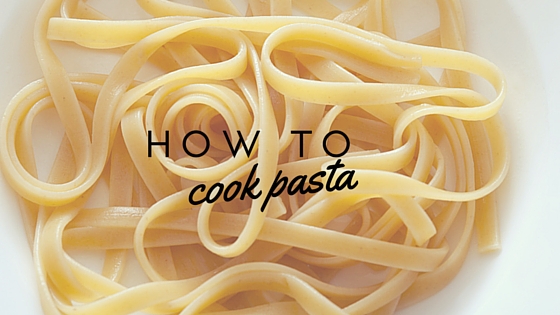Keeping up with our pasta theme for the month of January, today we’re going to talk about how to cook pasta. Now, pretty much anyone can follow the directions on the back of a Barilla box. But, there are tricks to get it to turn out as perfectly cooked pasta al dente. Here’s how to do it.
If you’re making your pasta from scratch – and kudos if you are – you’ll want to follow the directions for cooking that we talked about in our previous post on how to make pasta from scratch. This is because fresh pasta takes far fewer time to cook than dried pasta that comes in boxes or bags. And for this post, we’re going to assume you’re using store-bought pasta.
To start, find a large saucepan and fill it with water. As a general rule of thumb, use about 5 quarts of water for every pound of dry pasta you cook. Place it on the stovetop and turn the heater up to high in order to bring the water to a boil. Most people normally add in some salt and some olive oil at this point, but we aren’t going to do that. Olive oil doesn’t really prevent the pasta from sticking together or to the side of the pot. And adding salt too early to the process can slow down the process of the water reaching a good boil.
Now, once the water is boiling, you’ll want to add a tablespoon of salt. That may seem like a lot, but it’s how you flavor the noodles while they’re cooking, and once the salt dissolves in the water, a lot of it will be removed when you strain the noodles.
Once the water is salted, you’re ready to add in your dry pasta. Immediately cover the saucepan and allow the pasta to return to a boil. This should only take a few minutes, and once the water is boiling again, remove the cover to the saucepan and stir the pasta to ensure that it isn’t sticking to each other or the pot. Cook times can vary for different pasta types, but 9-12 minutes should be perfect. Like any good chef, you’ll need to taste the pasta at various stages in the cooking process to figure out when it’s ready. Start tasting 4-5 minutes into cooking until the pasta is firm, but chewy. This is what the Italians call “al dente”.
Once the pasta is done cooking, pour the noodles and water into a strainer to remove excess water. If you’re making a hot pasta dish, return the noodles back into the saucepan to cover with sauce immediately. Only if you’re making a cold pasta dish should you run cool water over the noodles. If you’re not sure what to top your pasta off with, you can never go wrong by mixing in a little olive oil, some sauteed garlic, bay leaves, and fresh tomatoes.
How do you like to cook and prepare your pasta? Share your tips with us in the comments!





